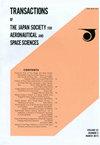基于波浪-水模型的音爆侵彻CFD研究
IF 0.8
4区 工程技术
Q4 ENGINEERING, AEROSPACE
Transactions of the Japan Society for Aeronautical and Space Sciences
Pub Date : 2021-01-01
DOI:10.2322/tjsass.64.273
引用次数: 0
摘要
音爆在海洋中的渗透及其影响程度的估计是超声速和高超声速航空的重要课题。大多数先前的研究都是假设浮水表面进行的。然而,众所周知,在真实的海洋环境中,表面波浪度的影响是不可忽略的。本文采用数值方法分析了音爆在空气和水中传播的二维流场。当飞机飞行马赫数高于4.4时,水下流场进入超声速,并在此产生音爆。数值结果表明,在水下亚音速区,穿透波在浮水面和波浪水面下均以消褪波的形式存在,但穿透波是由衰减率较小的波纹引起的。而在超声速水下流动中,水面波浪度对水下音爆侵深几乎没有影响,但会轻微削弱音爆强度。研究了表面波幅对水下穿透波的影响。:本文章由计算机程序翻译,如有差异,请以英文原文为准。
CFD Study on Penetration of Sonic Boom Applying a Wavy-Water Model
The penetration of sonic booms into the ocean and an estimation of the extent of their in fl uence are important topics for supersonic and hypersonic aviation. Most prior studies were conducted assuming a fl at-water surface. However, it is known that the e ff ect of the surface waviness is not negligible in the case of real ocean environments. In the present study, the numerical method analyzes the two-dimensional fl ow fi eld of sonic boom propagation across the air and water is proposed. When the fl ight Mach number of an aircraft is higher than 4.4, the underwater fl ow fi eld becomes supersonic, and a sonic boom is generated there. The numerical results show that, in the underwater subsonic regime, the penetrating waves have the form of evanescent waves under either fl at or wavy water surface, but the waviness-induced ripples with the smaller decay rate are responsible for deeper penetration. In contrast, in the supersonic underwater fl ow, the surface waviness hardly a ff ects the penetration depth of underwater sonic booms, although it can slightly weaken the boom intensity. The e ff ect of the amplitude of surface waviness on the underwater penetrating wave was also investigated. :
求助全文
通过发布文献求助,成功后即可免费获取论文全文。
去求助
来源期刊
CiteScore
1.80
自引率
0.00%
发文量
18
审稿时长
>12 weeks
期刊介绍:
Information not localized

 求助内容:
求助内容: 应助结果提醒方式:
应助结果提醒方式:


